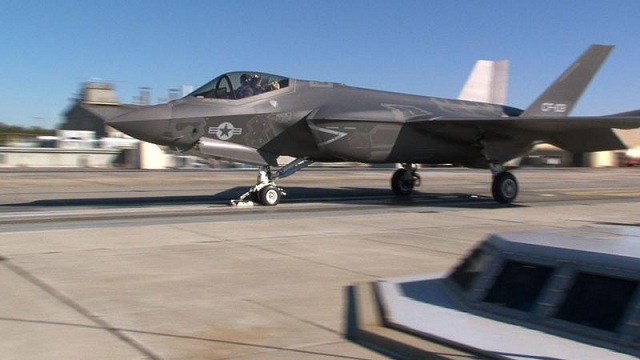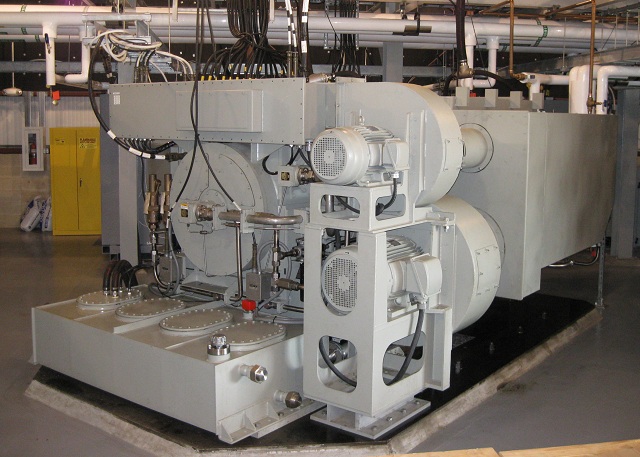| |
|||
| a | |||
Naval Forces News - USA |
|||
First U.S. Navy Sailors Trained on Electromagnetic Aircraft Launch System
(EMALS) |
|||
In
late October, 16 Sailors from the USS Gerald R. Ford (CVN 78) became
the first in the fleet officially trained to operate the Electromagnetic
Aircraft Launch System (EMALS). EMALS is replacing the current steam
catapult system on aircraft carriers, beginning with the Gerald
R. Ford (CVN 78). |
|||
 An F-35C Lightning II test aircraft piloted by Lt. Christopher Tabert launches for the first time from the new electromagnetic aircraft launch system. The new launch system will be installed on the aircraft carrier USS Gerald R. Ford (CVN 78). (U.S. Navy photo by David Sckrabulis/Released) |
|||
The initial 10-day training was created for senior
leadership either directly involved with launching operations or who
perform supervisory duties from CVN 78’s V-2 who maintain the
ship’s aircraft launch and recovery equipment.
These members of the ship’s pre-commissioning crew learned the ins and outs of EMALS during classroom instruction and the realistic experience of launching aircraft, under normal and abnormal scenarios, via simulation at contractor General Atomics’ (GA) Ship Set Control Lab in San Diego. |
|||
 The Electromagnetic Aircraft Launch System (EMALS) motor generator stores energy in the inertia of its rotor and releases that energy upon initiation of the aircraft launch onboard carriers. EMALS completed shared generator testing at Joint Base McGuire-Dix-Lakehurst, N.J., today. EMALS is replacing the current steam catapult system on aircraft carriers, beginning with the Gerald R. Ford (CVN 78). (U.S. Navy photo) |
|||
“Being a part of EMALS is a dream come true
… this is the ultimate to me,” said Aviation Boatswain’s
Mate (Equipment) 1st Class Earl Fowlkes. “Nine years in [service]
and I never dreamed I’d be working on something like this.”
EMALS Training Lead Terry Hotz suggested candid feedback from senior leadership attending the initial training session would be instrumental for improving the curriculum for future sessions, adding many of those receiving the training will be right there to support the initial check-out process and shipboard testing. “It is incredibly important that we provide the absolute best training possible to those who will be responsible for this critical equipment, ensuring they can safely do their job,” Hotz said. The entire effort to provide the critical training for EMALS has been one of collaboration, Hotz explained. Personnel from PMA-251, GA, the Future Aircraft Carrier Program Office (PMS-378) and the Center for Naval Aviation Technical Training (CNATT) combined efforts to ensure the training curriculum is comprehensive and robust. |
 EMALS Training Lead Terry Hotz, left, looks on as Aviation Boatswain’s Mate (Equipment) 1st Class Nathan Buckley, Aviation Boatswain’s Mate (Equipment) Chief Christopher Boone and General Atomics (GA) software engineer Omar Vega, work with the Electromagnetic Aircraft Launch System (EMALS) launch control monitor and officer stations during the first official EMALS training session last month at GA’s Ship Set Control Lab in San Diego, California. (Photo courtesy General Atomics) |
|||
“There will be much less wear-and-tear and there
is going to be huge cost-savings in the long-term with EMALS,” said
Aviation Boatswain’s Mate (Equipment) Master Chief Eric Young, who
will support the system’s flight deck certification aboard the Ford.
“This system doesn’t require the lube and hydraulic fluids
that are necessary to run the legacy system. EMALS is much cleaner and
easier as a whole. EMALS is less labor-intensive and more user-friendly.
The whole system is plug-and-play. If there’s an error of any kind,
we know where it is right away with the maintenance workstation.”
Five more training sessions will convene at Lakehurst between early 2015 and mid-2016, using the EMALS test site, where operators and maintainers from CVN 78 as well as CNATT instructors and Carrier and Field Service representatives will get up close and personal with the technology. Some of those courses are specifically slated for Electrician’s Mates and Interior Communications Electricians; rates that Hotz said will see an increase in the number of billets due to the electromagnetic technology employed by EMALS. “Going from legacy to EMALS has been a seamless transition,” said Aviation Boatswain’s Mate (Equipment) Chief Christopher Boone. “They kept the systems very similar and familiar, but made things much easier as well.” EMALS is currently being installed and undergoing numerous subsystem assessments on the path toward shipboard certification. The system is slated to make its debut in the fleet aboard the USS Gerald R. Ford (CVN 78), scheduled to deliver in 2016. “There is a great deal of excitement surrounding EMALS and its imminent debut aboard the Ford,” said Aircraft Launch and Recovery Equipment Program Office (PMA 251) Program Manager Capt. Stephen Tedford. “This technology stands to impact the future of naval aviation for the next half century and well-trained personnel are critical to its integration in the fleet and continued success.” |
|||










